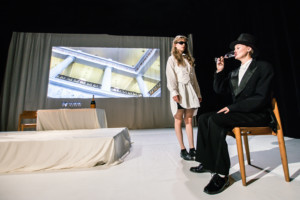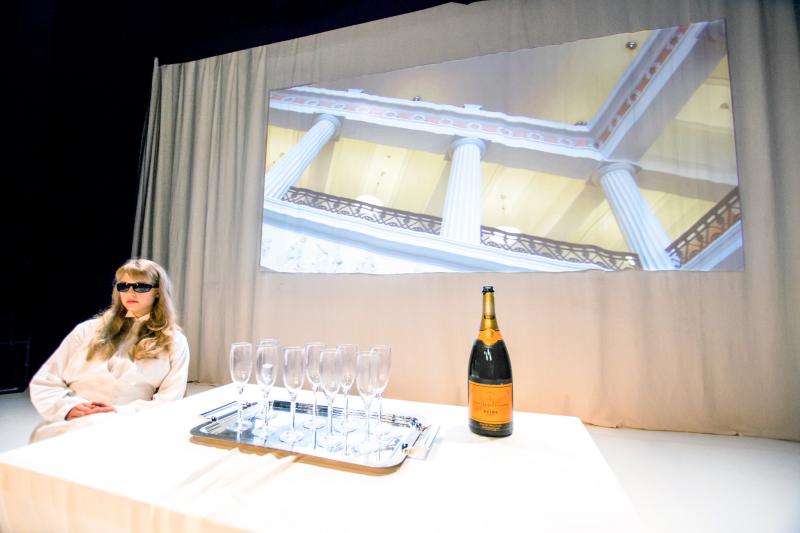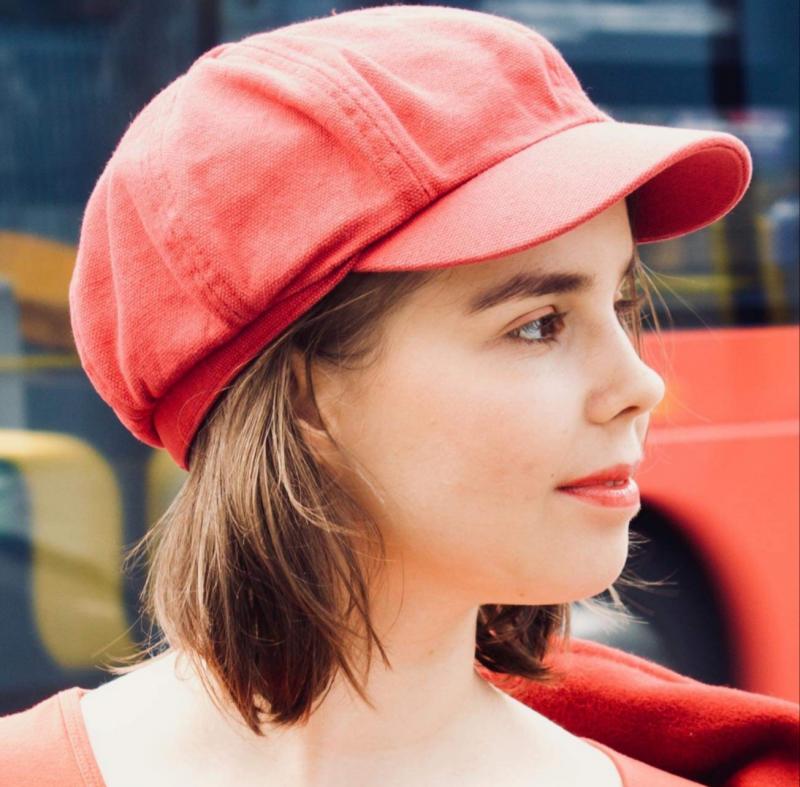Review: TURKKA DIES has its moments, but lacks focus

Ruusu Haarla: concept and scriptwriting, directing and dramaturgy, on stage, set design, videos, costume design, Sound design, research
Julia Lappalainen: concept and scriptwriting, on stage, costume design, research
Fabian Nyberg: Stage design, videos, light design
"I'm a broken crock..."
Both of the actors walk across a half-circled stage. They carry bags and glance at the projection on a curtain: Jouko Turkka 1942-2016
Jouko Turkka is nothing less than a legendary man, usually referred as a genius, who's mostly known as a theatre director and a writer. His chaotical lead in the Finnish Theatre Academy in the 80s made a lasting mark to the students, politicians and press alike.
Ruusu Haarla (actor, director etc.) and Julia Lappalainen (actor, etc.) find their seats on different sides of the stage and we've been given a moment to listen to Jippu's "Broken crock". The song gives mind-blowing and impressing moments as the lyrics, like "You loved me so much that you wanted to (break me and) make me new" and "in the Master's hand (to be crafted) I'd be" clearly pointed out to Turkka's methodology and to him as a worshipped idol. And to one of his directions "The broken pot".
Next to both of the chairs lay dozens of books. They're the books from which the workgroup has done their research from, though to an audience member sitting at the back like me it's made known in the moment-- at least to me-- when Lappalainen as Jussi Parviainen grabs one and starts to read it. The front rowers were able to read the titles.
The beginning moments, let's say five or so, are important in any kind of performance. It gives the base and a platform to which the rest of the show is built on, in a way out another whether the style is broken or not, because those are the first moments the audience gets to have.
The beginning of Turkka Dies is good: the song, the "interviewing" of the Seven brothers -actors of Turkka's direction that are projected on screen, though the timings are a little off at times and we have to wait for the reactions to the headlines that our main actors on stage speak.
So up to this point the audience has gotten an image that the headlines are spoken in a mic, and at times we see videos projected. Why wasn't this, for a one example, properly benefitted from and utilised in the rest of the performance in terms of a clear focus and distinctive, rooted elements of storytelling that any good performance has to have? Or at least a clear motive why it was broken.
The show unfortunately had too much stuffed into it, things that weren't enough digged into the plot or given a performatical motivation, neither proper space for example in terms of sucking the audience in: the actors' own family tragedies, which confused my avec that was it supposed to be sad, ironic or funny; the actors' friendship and personal life that was projected on screen at confusing moments, like when they were born or how they laid as friends in the same way they ended the final, otherwise beautiful scenic image of the show; dia-like projections either of headlines, quotes or informative notes on research material, like "the next scene is inspired from..."-- but all are in the same kind of font, apart from some yellow underlinings.
Many of the quotes are too long, and that's not even the problem, but we're not given time to read them as something starts to happen on stage almost at the same time, even some line delivering.
The only exception to this was the extremely good scene of the Theatre Academy auditions where headlines were projected on the screen in a great rhythm as Turkka (performed by Haarla) shouted in between backstage some very characteristic lines, meanwhile an auditionee (Lappalainen) worked out in front of the screen. That scene greatly united audience's capability to focus and different areas of senses, which is important in theatre: informatic text (audience has to focus; sense of sight when reading), shouting (audience doesn't have to focus that much to understand the short, vague lines; listening) and movement (audience dosesn't have to focus that much to understand it; sight) so very well done!
Other good moments were the interviews of the former students of Turkka, though in Satu Silvo's case it was confusing how she was constantly interrupted at the beginning, so I thought that if the info from the workgroup is more important at that point than Satu, why wasn't the beginning minutes of her interview a mere audio clip? You could claim that Satu's reactions are important to the girls' informative backstory to the play, which is fine-- fine that they tell about it for half a minute or so, but little by little Satu's reactions change more from listening in interest to micro-expressions of the surprise of being interrupted.
The one that fully takes on the role of Jouko Turkka as a character is Katja Kiuru for sure. The moment on the video where they visit the Helsinki University and Kiuru re-lives the shocking and disturbing moments she experienced years bakc, now on the video as Turkka, still shooks me when I think of it. How it ever could have happened; harrasment on sight, and no one dared to say back at the wide-smiling idol of those times? My goodness. So, when Kiuru's Turkka is passionate and perhaps performed through a bubbling hate and astonishment towards the man himself, which is good, Harla's Turkka and the distinctive gestures and facial expressions are on point too, but she kept on dropping the character from time to time.
The tour at the old Theatre Academy is very interesting as well, especially when I'd just recently read Eppu Salminen's book of the same happenings, and Eppu was referred to in the video too. But why oh why did the subtitle change font in the middle of the stairs? It'd have been more suitable to choose a font that works throughout the clip.
And why was the Eppu (performed by Lappalainen) to whom Jukka Parviainen speaks to from the video hugged on the video when he clearly stood on stage? It didn't fit to the base idea of the use of the videos we'd gotten from the interview of the Seven Brothers and didn't seem to have a clear, dramatical reason to it.
Otherwise, another fantastic moment that's created on stage in is the one where Eppu aims to hit Turkka. The transition is choreographically amazing! More of those  kind of moments (like the Theatre Academy auditions -scene too of which I mentioned earlier) I surely anticipated and was proud of, and would have needed more! Also the "I'm not no animal in the Zoo" -song scene and how Turkka, of whom was very nasty things spoken about just a moment ago, slowly lithered on stage-- the tension of it was amazing! I also enjoyed the Darude glasses -detail to symbolise the early 2000s.
kind of moments (like the Theatre Academy auditions -scene too of which I mentioned earlier) I surely anticipated and was proud of, and would have needed more! Also the "I'm not no animal in the Zoo" -song scene and how Turkka, of whom was very nasty things spoken about just a moment ago, slowly lithered on stage-- the tension of it was amazing! I also enjoyed the Darude glasses -detail to symbolise the early 2000s.
All in all Turkka Dies has too much ambitious material that is not properly formed into clear pieces that the audience could swallow without ceasing in unnecessary confusion. It totally has its moments, especially at the second half, and had potential, but should have been focused more properly.
Perhaps Jippu's Broken crock at the end of the show could have been a great add so the show could have come full circle; the audience could have re-thought about the lyrics, based on the info they now know about Turkka.
Photos: Carolin Büttner from Tampere's Theatre-summer
Article: Rosanna Liuski

Videos

